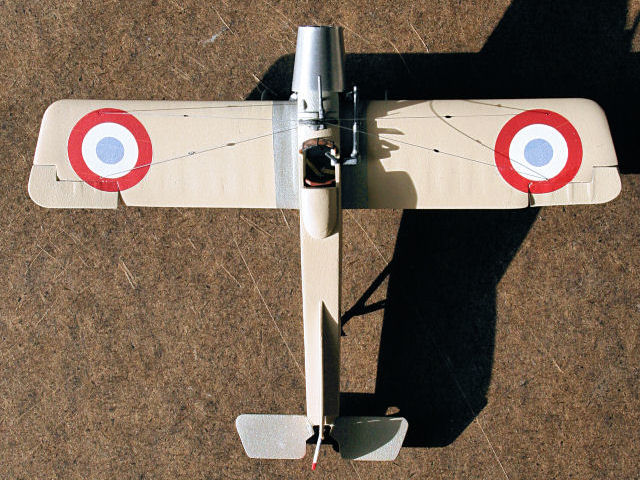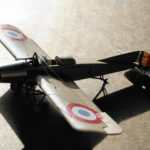A few years ago, I bought a bag of second hand 1/72 WWI planes. Most were old Revell kits except for one pristine ESCI Neiuport 17. The Revell kits were in bad shape; most were missing decals, instructions or parts, so I got them all for less than $10.
The worst of the lot was a Fokker Eindeker E-III. It was missing several vital parts and the plastic was about as brittle as a resin kit.
I wanted to make the most of what was left, and came up with the idea of turning it into a variant of the Morane-Saulnier type G or H, which looked remarkably like the Eindekker.
I decided to make it a what if – what if the Coanda powerplant had been developed past 1910? It wouldn’t have displaced piston engines due to the heat generated by the exhaust and by its high fuel consumption, but what if in 1915, Messrs. Morane & Saulnier had developed an engine with a performance that rivaled or surpassed existing designs? For one, you wouldn’t need an interrupter for the guns.


I started the model by replacing the major structural components that were missing or damaged in the kit. Most of the white parts (like the tail plane and rudder) are replacements. I also cut ailerons into the wings because wing warping is so 1914!

I used ShroudCalc to produce the pattern for the cowl. The first one was of paper, the second out of a Coke Zero can, and the third out of 0.005″ brass. I was surprised at how easy it was to produce the cowls – less than 10 minutes each from start to finish. I crimped the metal cowls to close them and the results – I think – look very WWI-ish.
I designed the pattern for the impeller/fan in Canvas, printed it out, glued the paper to thin brass shim stock and cut the part out. I didn’t like the first fan so I made a second, with wider blades. The first fan is now behind the radial engine. The second will act as the compressor.
After most of the parts were made, I printed some decals and painted the plane in tan. The areas that would get hot on the wing roots and the elevator were painted in steel and represent aluminum doped wing surfaces, or aluminum covered wood. I sanded down the upper surface of the main wing because the rib and fabric effect were just ridiculously overdone on the original kit.

This is a low port side view. I moved the compressor blade forward and painted the brass aluminum. I used the cowl made from the Coke Zero soda can, because nothing says aluminum like aluminum! Removing the paint from the soda can was difficult; I ended up having to sand most of it away. I added exhaust tubes and blast deflectors and moved the tail skid forward to keep the plane almost level on the ground. We don’t want to start fires on takeoff!

The headrest is half a lifeboat from an old Revell T-2 tanker.
I named the plane “Petit Pet” (little fart) because it seemed like a fitting nickname. The nickname is only on the left side. The tail codes are completely made up, but follow the pattern seen on many Morane Saulnier airplanes of the period. The lower letters “Type Rc” stand for “Type Réacteur-Coanda”.
I made decals for the wheels because I didn’t feel like painting them. Missing at this point are the cockpit fittings, machine guns, windscreen and the most “fun” part, the rigging… which will be minimal.
The top view of the finished plane shows the rigging, made from “invisible” nylon thread, painted titanium. The blobs on the rigging are the turnbuckles. They’re made from chain links from a 1/350 scale photoetched anchor that I made. Note the big gun on the starboard side.


This is a better view of the “Gotha Buster”. It’s a 4 barrel small caliber automatic Gatling gun powered by a reduction gear coupled to the engine. In this What if scenario, the gun was suggested by Georges Guynemer as a way to destroy the large Gotha bombers quickly. While the bullets were of small caliber, the gun was able to deliver a large mass of bullets to the target in a very short period of time. The gun had a tendency to jam if more than 80 rounds were fired, so the magazine was limited to 80 rounds. A single standard aircraft machine gun was mounted in front of the pilot, with a much slower firing rate but more ammunition. “Hans”, (or “Georges”, in this case) the standing figure is from the Preiser 1/72 Luftwaffe figure set.
This was a fun project, and I made good use of a kit that seemed destined to never be completed, due to its missing parts.
Updated August 5, 2020




